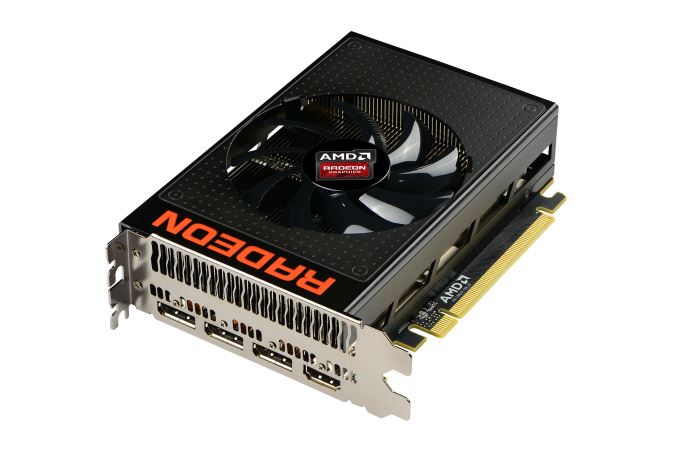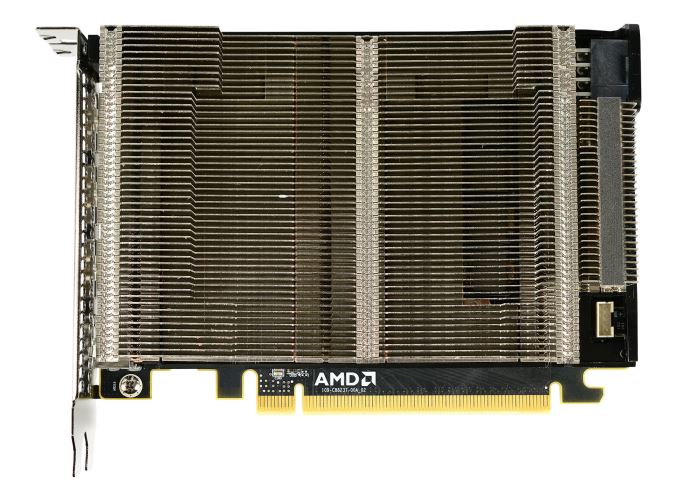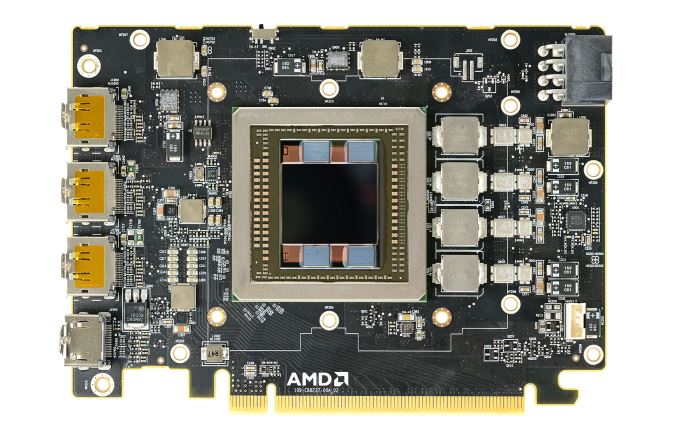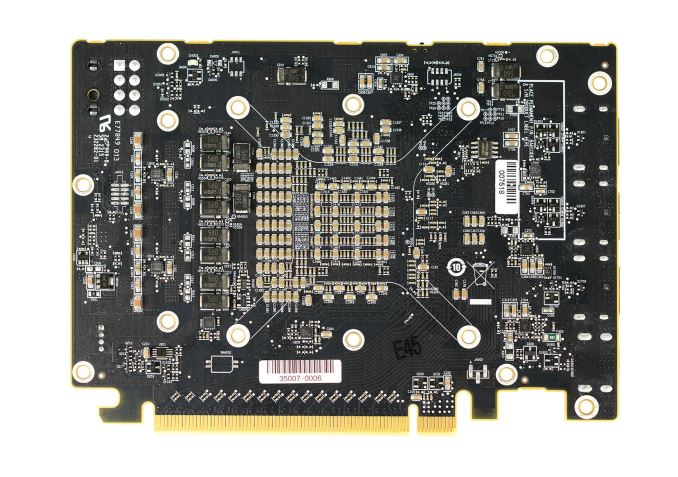The AMD Radeon R9 Nano Review: The Power of Size
by Ryan Smith on September 10, 2015 8:00 AM ESTMeet The Radeon R9 Nano
6 inch video cards are by no means a new thing in the GPU space, however these are traditionally lower-end products that need neither a large cooler nor an extensive power delivery system. As a result the R9 Nano is something of an interesting aberration, packing a lot more power and a lot more technology into half a foot of video card than what we normally see.
Starting as always from the top, the R9 Nano measures 6” long, which is actually a bit shorter than the full length the Mini-ITX standard allows. Responsibility for cooling the card falls to the R9 Nano’s new open air cooler, an aggressive design that has been specifically tailored to allow the card to effectively dissipate 175W of heat in such a small space.
The overall design of the R9 Nano’s cooler is best described as a combination open-air and half-blower hybrid. The design is technically open-air, employing a single axial fan to cool the card. However with only a single fan AMD has been able to align the heatsink fins horizontally and then place the fan in the center of the heatsink. The end result is that roughly half of the heat produced by the card is vented outside of the case, similar to a full blower, while the other half of the heat is vented back into the case. This reduces (though doesn’t eliminate) the amount of hot air being recycled by the card.
The heatsink itself is composed of aluminum and runs virtually the entire length of the card. This is technical a two-piece heatsink, with the primary heatsink composing the bulk of the card, while a much smaller secondary heatsink it found towards the far end of the card and mounted on top of a heatpipe.
Drilling down, we find that the primary heatsink is fed by a combination vapor chamber and heatpipe design. A copper vapor chamber serves to draw heat away from the Fiji GPU and HBM stacks, and then heatpipes are used to better distribute heat to the rest of the heatsink. The use of a vapor chamber in the R9 Nano makes a lot of sense given the fact that vapor chambers are traditionally the most efficient heatsink base type, however the R9 Nano is also unique in that we typically don’t see vapor chambers and heatpipes used together. Other designs such as the high-end GeForce series use a single large vapor chamber across the entire heatsink base, so among reference cards at least the R9 Nano stands alone in this respect. In this case given AMD’s design goals for size and noise, a vapor chamber will play a big part in helping the small card effectively and quietly dissipate 175W.
As for the physical PCB itself, as we can see AMD made it a relatively packed card in order to get the R9 Nano down to 6 inches. Compared to the R9 Fury X reference board, the biggest change here is that AMD has removed a fair bit of power circuitry to save space. By our count there are 4 VRM phases to feed the Fiji GPU, as opposed to the 6 found on R9 Fury X. Power delivery is handled by a single 8-pin PCIe power socket, which is becoming increasingly common, replacing the 2x 6-pin setup for 150W-225W cards.
Meanwhile to further shrink the overall PCB footprint, AMD has moved some of the remaining power delivery circuitry to the back of the card. The front of the card still contains the inductors and heat-sensitive MOSFETs, while a number of capacitors are on the rear of the card (and is why you won’t find a backplate).
Finally, for display I/O R9 Nano is unchanged from R9 Fury X. This means we’re looking at a DVI-free design, with 3x DisplayPort 1.2 and 1x HDMI 1.4 port all along a single row of the I/O bracket. Buyers looking to put together HTPCs will want to be especially mindful of the HDMI 1.4 port; while it's not necessarily a deal-breaker, it does mean that the R9 Nano can't fully drive 4Kp60 TVs, which are slowly but surely becoming more common.
Overall AMD is rather confident in their design for the R9 Nano. The heatsink is built to efficiently dissipate more heat than the 175W the card requires (despite the small size), and as a result we never see the R9 Nano thermally throttle under normal operation. The card’s thermal throttle point is 85C, and in our testing the card never passed 75C, exactly as AMD promised us. What ends up limiting the R9 Nano’s performance then is exactly as expected: the power throttling.
















284 Comments
View All Comments
zodiacfml - Saturday, September 12, 2015 - link
Yawnn.. It's not bad till you get to the price. Fury X now has better value as you get watercooling.paravorheim - Saturday, September 12, 2015 - link
"Meanwhile Fury X’s massive power headroom has been significantly curtailed, from a TBP of 275W (and in practice a cap much higher than that) to a much harder TBP limit of 175W for the R9 Nano."You say TBP here, is that supposed to be "TDP"? I saw it in a few other places as well.
SunnyNW - Monday, September 14, 2015 - link
TBP (Thermal Board Power) vs TDP (Thermal Design Power)The0ne - Monday, September 14, 2015 - link
Bin parts for power and cooling efficiency instead of a good design isn't something to rave about. It should be something to write off of because, lets faced it, nothing is different from the previous designs.medi03 - Monday, September 14, 2015 - link
Yeah, "previous designs". Like 290x that beat that day Titan at a fraction of price.Gnomer87 - Tuesday, September 15, 2015 - link
While an improvement in the efficiency segment, this card still loses out to Nvidias alternatives, most notably the older 980. The 980 performs only marginally worse, while having a smaller price tag.It's still a walkover, if I were to replace my hd 7950b today, it'd still be nvidia. This is a problem, if AMD doesn't get their shit together, they're going bankrupt.
And that means monopoly.
Oxford Guy - Tuesday, September 15, 2015 - link
Is there a 980 in this form factor? If not, then it doesn't lose because there is an AMD card that outperforms the 980 for less money as far as I know.IlllI - Tuesday, September 15, 2015 - link
love the nano, can't justify the price. up until now i thought it was going to be $499. the Fury X i can justify the price b/c you can look at it as having a $100 liquid cooler included. but for the nano to be the same price as the Fury X.. I just can't.gw74 - Wednesday, September 16, 2015 - link
AMD_Roy twitter account has been deleted!JonnyDough - Tuesday, September 22, 2015 - link
Wow, lots of crap in the comment's section. I'll post my own. Smaller is better. The trend of hotter, louder, heavier, and more energy guzzling cards was terrible. Not only did it KILL some of my PCI-E slots after awhile from the sheer weight of the card, but most of the old hot running cards are now dead and don't work. It's nice to see a nano card that can fit in an ITX case comfortably. Here's to LAN parties of the future, and more room on/under desks!